

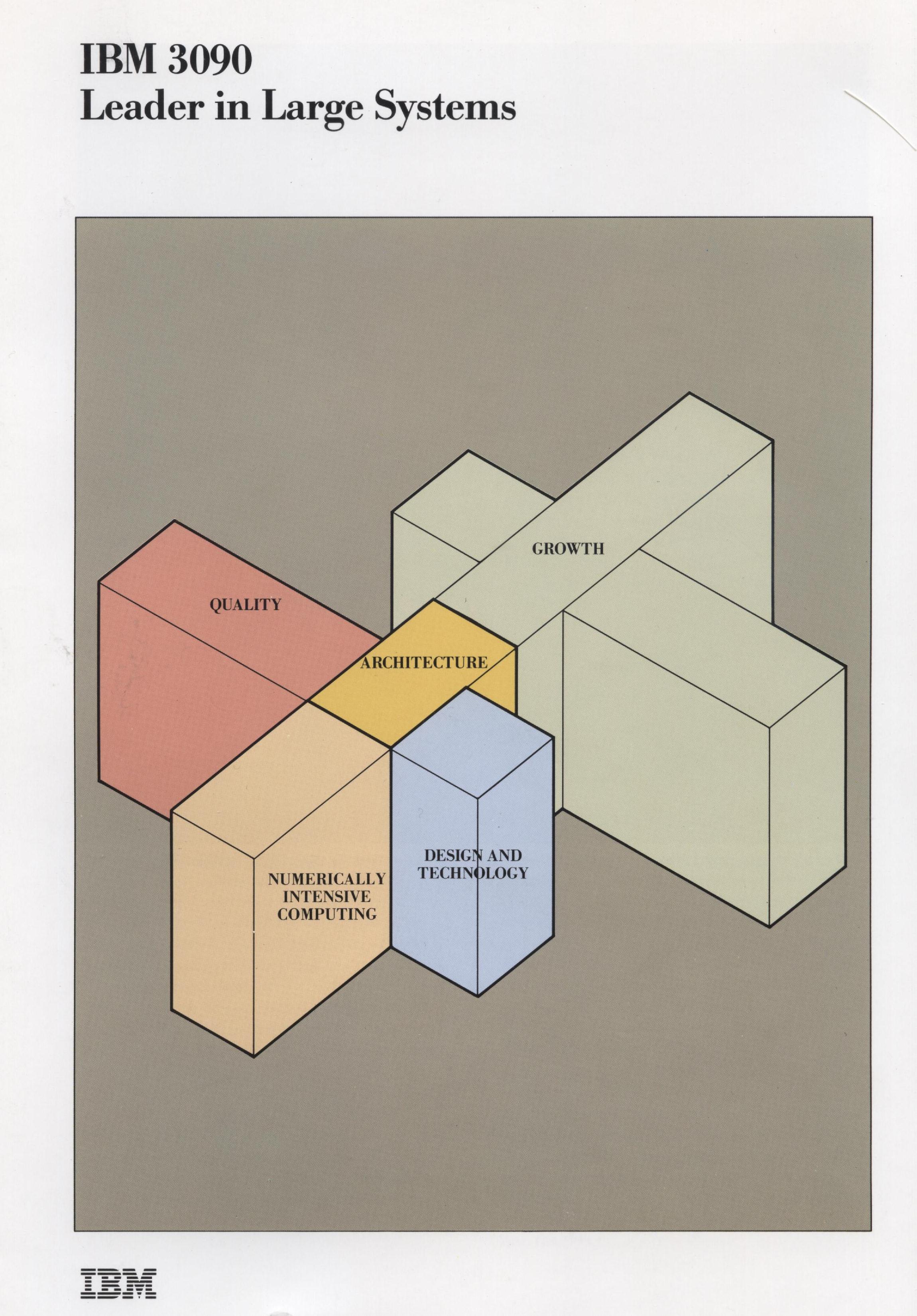
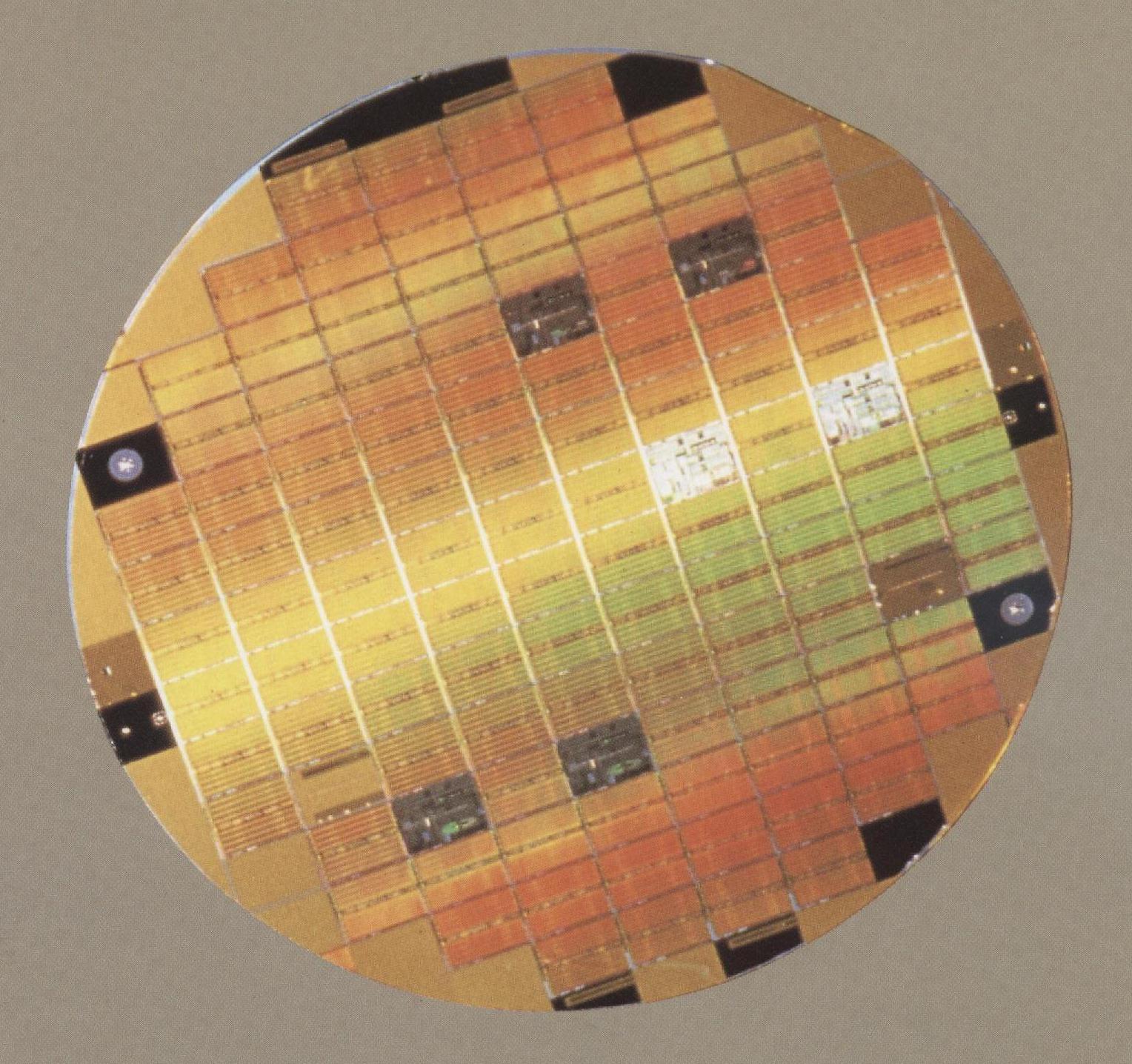
It is over 20 years since IBM customers started running their first System/360 programs, programs they can still run today, unmodified, under System/370 Extended Architecture.
In 1966, the largest IBM System/360 commercial computer installed was the Model 65.
Today's 3090 Model 600E, IBM's most powerful computer so far announced, is a multiprocessor more than 100 times as fast, reflecting the growth of data processing in your installation and those of our other large customers. Data processing now permeates most organisations, affecting every aspect of their activities, as online applications, office systems and personal computers become the norm in most departments. The seven enhanced models of the IBM 3090 are designed to satisfy your processing requirements, both commercial and compute intensive.
Being involved in the planning and operating of the large systems at the heart of your organisation, your success contributes directly to meeting and exceeding its goals. New applications installed on-time, a high level of service which provides fast end-user response and continuity of operation, as well as the ability to satisfy unexpected demands for additional computing power: all help to give your organisation the effectiveness it needs to meet its targets in business, government, research or education.
More power and improved availability As your applications continue to develop and your end-user population continues to grow, you need planned increments of computer power and improved system availability: computer power that can be added, without disrupting existing operations, and availability that is a reality from the end-user's view-point.
Today, you can choose from a highly granular range of IBM 3090 models. Added to the existing models 150, 180, 200 and 400, are the enhanced models 150E, 180E, 200E and 400E. Now, three new models extend the family range with the introduction of models 120E, 300E and 600E. Existing 3090 installations will be able to benefit from new levels of price/performance, as well as the new growth options, because all previously available 3090 models can be upgraded to the enhanced models when more capacity is needed.
IBM's 3090 family uses proven IBM technology, proven IBM software and IBM's System/3 70 Extended Architecture, all specifically designed to provide unconstrained growth and high availability, all setting standards of leadership that others follow.
The benefit to you and your organisation in using the IBM 3090 to perform your data processing is that you get the original IBM product, designed, built, tested, installed and warranted by IBM: it provides the full function specified, its availability is designed to be superior to the previous family of IBM equipment and it has been shipped in volume ahead of schedule.
In addition, you have the opportunity to use the full range of IBM's product line, designed to provide a total system solution with a matched set of hardware, software and microcode to meet your data processing and communications needs, and supported by what is generally acknowledged to be one of the best customer service operations in the world.
The existing models of the IBM 3090 have been installed in substantial numbers in customer locations, with outstanding success according to customer reports. Introduced in 1985, world-wide shipments of the Model 200 began the same year, ahead of schedule.
The Vector Facility, which makes the 3090 a full function scientific computer with vector as well as scalar and parallel processing capabilities was installed in volume in 1986, as were the models 150, 180 and 400. Now, both the enhanced and new models 120E, 150E, 180E, 200E, 300E, 400E and 600E all become available in volume in 1987. As a result IBM expects to maintain its leadership as the supplier of the most powerful available System/370 computer in the world.
Already, two years after the initial Model 200 announcement, the 3090 family has been extended to provide an up to ten-fold field upgradeable growth path. The IBM 3090's attractive price/performance permits you to satisfy your growth, function and availability requirements this year while making a financially attractive investment in IBM's base for growth into the 90's.
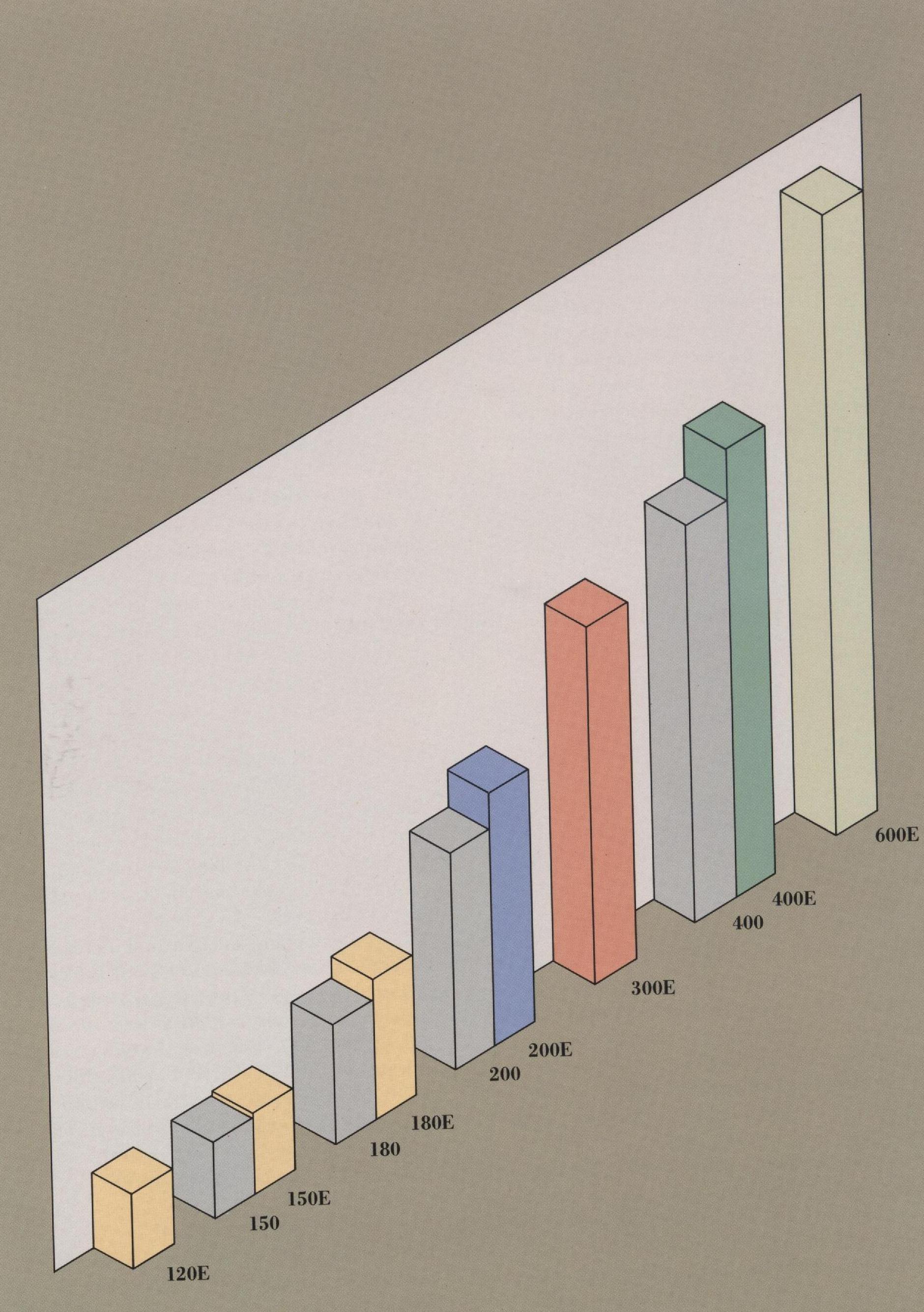
In 1968, IBM announced the System/360 Model 65MP, the first IBM multiprocessor for general purpose computing. Since then, IBM has continued to develop new multiprocessors to meet customers' requirements for high growth within a single machine. The IBM 3033 was extended to provide greater than three-fold growth within the family and the mature IBM 308X series offered ten-fold internal growth.
The two-year-old IBM 3090 family, with is newly-announced models, now provides a series of uniprocessor, dyadic, triadic, four-way and six-way processor units, as well as from one to six optional Vector Facilities.
The seven enhanced IBM 3090 models provide up to ten-fold growth from the Model 120E to the Model 600E processor unit. Upgrades can be performed quickly: in as little as approximately one shift depending on the model. At the lower end of the performance scale, the Model 120E provides significantly more commercial throughput than an IBM 4381 Model Group 14, while at the upper end, the Model 600E is expected to be up 2.8 times as fast in internal execution rate as an IBM 3084 Model QX. Scientific performance is even better. The IBM 3090 therefore provides the growth path for all users of IBM's 4381 and 308X series, whose future needs exceed the capacities of these families.
Moreover, the IBM 3090 is the machine which offers, in one processor unit, Expended Storage, a powerful vector processing capability and the most complete implementation of IBM System/370 Extended Architecture - the base for IBM's future large systems direction. It is therefore especially suitable for users of "IBM-compatible" processors who wish to realign themselves with IBM, as well as users of non-IBM equipment who wish to benefit from IBM's own implementation of its architectures.
IBM's long experience in multiprocessing has resulted in the exceptional, measured, performance relationship between the uniprocessor, dyadic, triadic, four-way and six-way models (as shown above), thus providing evidence of IBM's leadership in multiprocessing: leadership which IBM can exploit to extend your growth options within the limits permitted by System/370 Extended Architecture.
The outstanding performance of IBM's functionally most advanced large processor complex, combined with the attractive price of the model upgrades within the 3090 family, makes it an excellent investment to support future processing requirements and to avoid repeated, disruptive and expensive replacement of the processor unit.
To permit you to match your storage and channel configurations to your applications and balance your IBM 3090 System, the amount of processor storage and channels can be tailored. Central and optional Expanded Storage, including new larger Expanded Storage options, combine to provide from 32 Mb minimum processor storage capacity on the Model 120E to 1280 Mb maximum on the Model 600E. Channel options range from 16 minimum on the Model 120E to 128 maximum on the Model 600E, an eight-fold increase, with all channels capable of operating at 3 Mb per second to support IBM's advanced double capacity 3380 Disks and innovative 3480 Tapes.
All 3090 models may incorporate an enhanced integrated Vector Facility for each central processor, offering exceptional price/ performance for compute intensive users. Fitted to the Standard IBM 3090 Central Processors, the optional Vector Facility gives a significant throughput improvement, running vectorisable applications. The Vector Facility and the other special features of the 3090 which make it even more attractive to engineers, scientists and analysts are summarised later in this brochure.
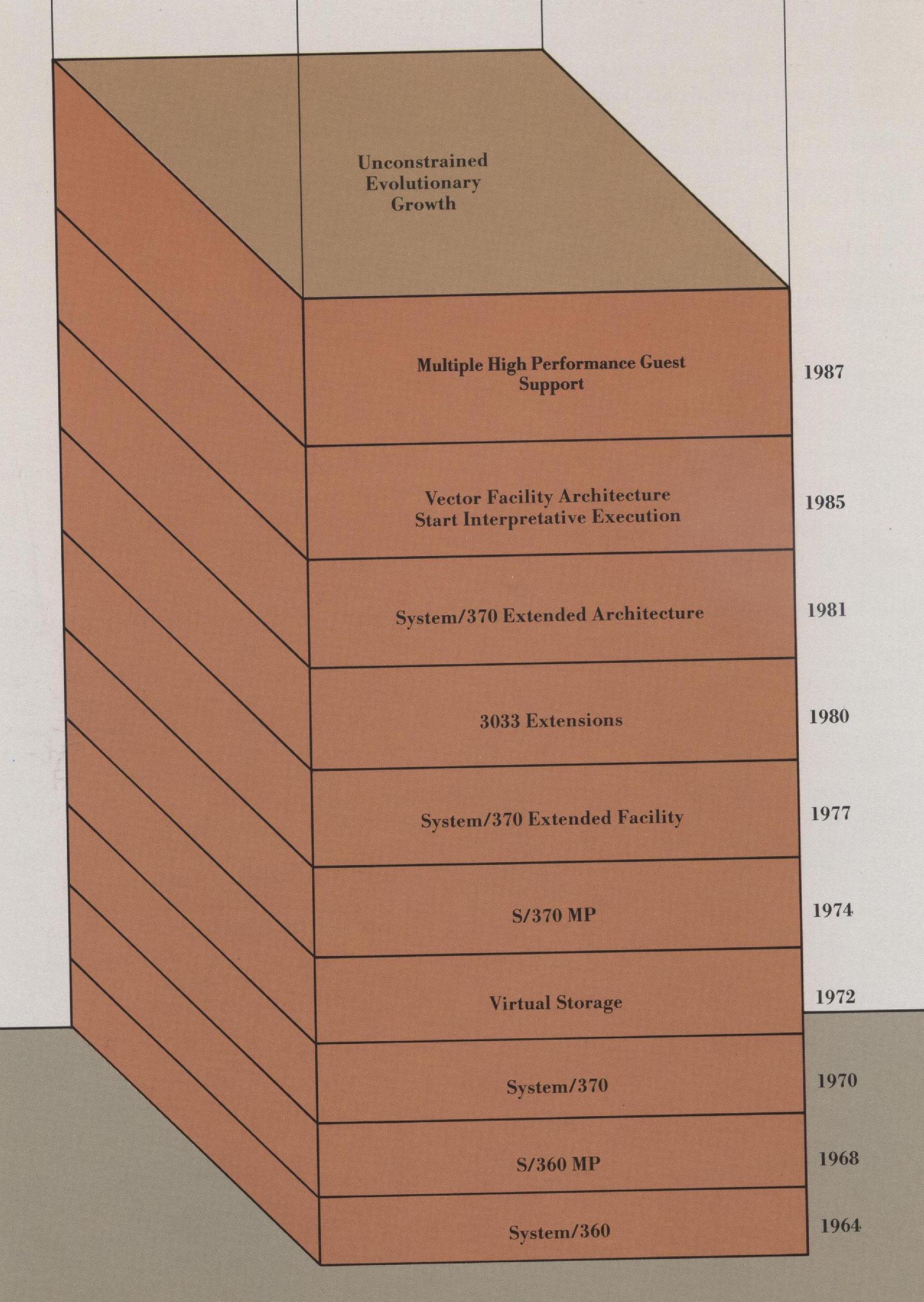
The IBM 3090 continues IBM's history of evolution and coexistence, supporting the previous System/370 Architecture alongside the current System/370 Extended Architecture (XA), the base for IBM's future large systems direction.
IBM System/370 Extended Architecture is the latest version of the most successful evolutionary architecture in the DP industry. As with all previous developments of the original IBM System/360 architecture, System/370 XA was introduced for one reason only: to allow customers' DP growth to continue unconstrained. To permit this, it provides Central Storage addressing of up to 2 gigabytes (Gb), Expanded Storage accessing up to 16 terrabytes (Tb) in 4Kb blocks, and virtual storage addressing of up to 2Gb per address space, with up to 64K address spaces allowed.
Within the system configuration, there can be up to 256 channels and 64K devices, with n-way multiprocessing. Logical channel addressing by the processor replaces physical channel addressing in the System/370 XA Dynamic Channel Subsystem, delegating physical channel handling to the channel subsystem. This increases the flexibility with which channels are used and improves response time or channel utilisation as a result.
Three system control programs (SCPs) - MVS/XA, VM/XA System Product and VM/XA System Facility- support IBM System/370 XA. They are the strategic SCPs for IBM large systems and their functions are being continually expanded, not only to support new hardware like the IBM 3090 and new IBM-unique features like Expanded Storage and the Vector Facility, but also new functions in other IBM mainline software.
Bimodal operation within System/370 XA permits programs compiled under System/370 to be executed in parallel with System/370 XA-compiled programs, avoiding the need for program conversion.
The Start Interpretive Execution (SIE) command, which is part of System/370 Extended Architecture, provides a virtual machine capability. The SIE Assist is a microcode function that provides guest support for MVS/370 with near native performance. This SIE Assist is unique to IBM-built processors.
Virtual Machine Assist is another IBM microcode function, used by VM/XA to provide enhanced performance for VM/SP and VM/SP High Performance Option guests.
Multiple High Performance Guest Support is an IBM hardware function that permits a 3090 computer to support up to four guest systems under the VM/XA System Product, with near native overall performance.
These IBM architectural and functional capabilities permit 3090 users to use a mix of IBM system control programs (SCPs) on a single computer, when migrating between SCPs or in order to benefit from complementary SCP facilities, while retaining high performance.
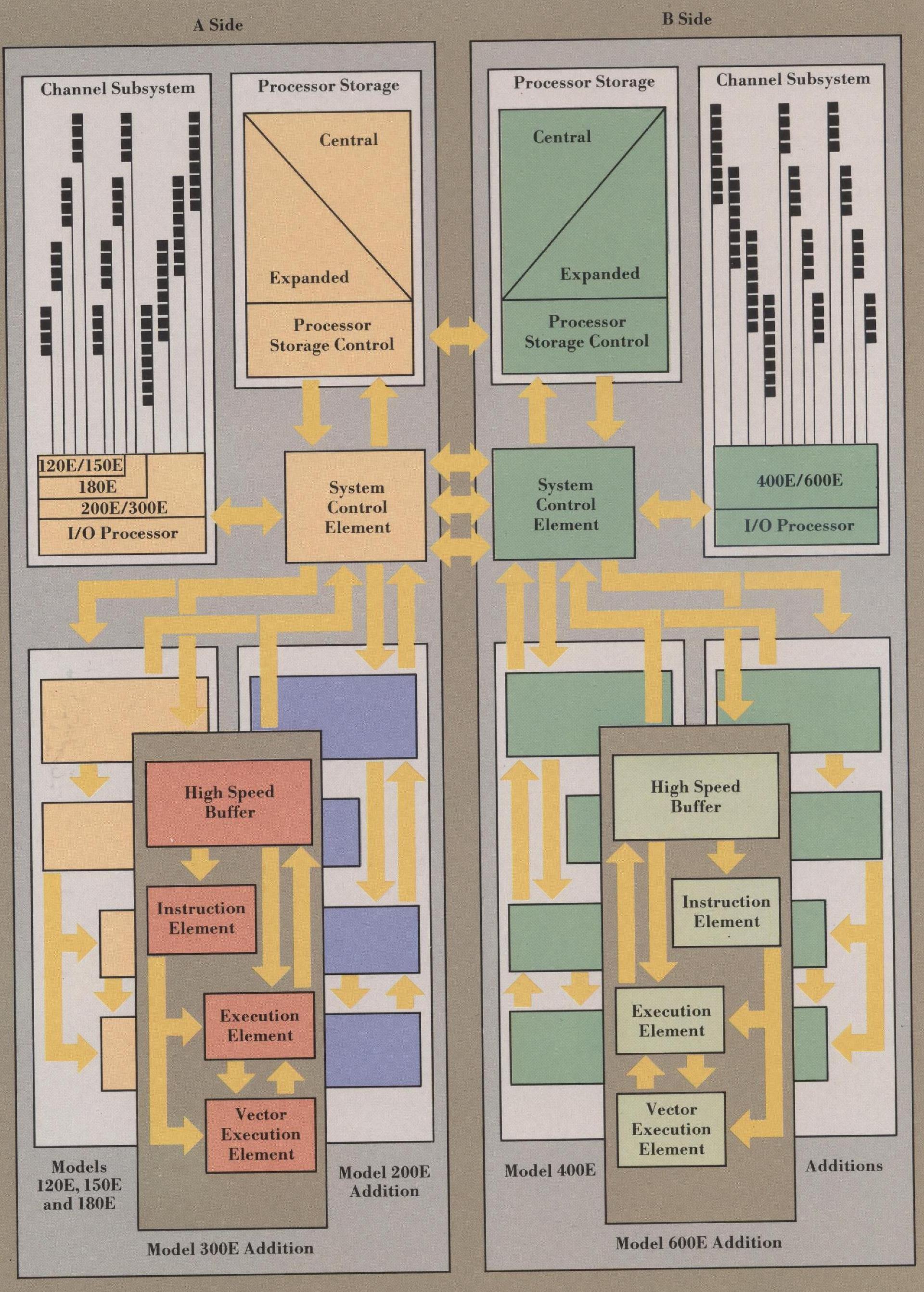
The 3090 Model 600E is currently the most powerful single image system using IBM architecture available for delivery in 11987. It also offers the highest measured performance of any multiprocessing system using IBM architecture. These achievements enable many IBM customers to grow their installations within the framework of a single logical system, with the accompanying operating, scheduling, performance and cost benefits.
The 3090 combines proven IBM technology with advanced design to provide the growth path needed by existing large systems users. It also provides numerically intensive users with integrated vector processing capability. IBM's proven Thermal Conduction Module (TCM) and TCM board technology provide the packaging for the 3090 with faster Emitter Coupled Logic (ECL) chips replacing the Transistor Logic (TTL) chips used in the IBM 308X. This adaptation of the technology allows the 3090 to have a cycle time as low as 17.2 ns compared to the 24 ns of the 308X "X" models, an improvement of 28 %. The remaining performance difference is achieved by significant design enhancements in the 3090.
A key design improvement in the 3090 is the high degree of overlap between the Instruction Element and the Execution Element for both commercial operations and scalar computation. Up to seven instructions can be processed simultaneously.
To keep the highly-overlapped Instruction and Execution Elements of the 3090 supplied with data and instructions, there are multiple 64-bit wide data paths between the Central Processor elements and Central Storage. Other 64-bit data paths link the High Speed Buffers via the System Control Elements in the multiprocessing models for rapid data interchange.
Implementation of instructions for floating point computation in hardware, plus other design features introduced to increase efficiency for numerically-intensive applications, results in outstanding scientific performance.
Expanded Storage is an innovative way of storing large quantities of data in the processor unit, and provides new application opportunities. It stores data in 4Kb blocks, completing a page transfer in microseconds, far faster than external disk and cache devices, which require input/ output operations to be scheduled and need milliseconds to transfer a page.
Transparent to end user programs, Expanded Storage is managed by the system control program. Because data is accessed at the page level, fewer addressing and control circuits are required for a given quantity of storage compared to Central Storage. This permits the cost to be reduced. Expanded Storage therefore provides customers with an excellent opportunity to improve response times by reducing or eliminating external paging, with consequent savings in external paging hardware. Furthermore, it allows application programmers to use virtual storage more freely: for example, for sorting or array processing.
I/O is handled separately from the central processors by the channel subsystem leaving the central processor free to proceed with program execution. Each channel has its own microprocessor which is managed by the Channel Subsystem I/O Processor (IOP). The IOP handles the path management functions of System/370 Extended Architecture. It uses a Reduced Instruction Set Computing (RISC) architecture to attain a higher level of performance, flexibility and growth.
In July 1985, IBM became the first in the industry to start volume production of the one-megabit memory chip announced to the research community in 1984. But early in 1985, even before production of this chip began, IBM announced a second, smaller and faster one-megabit memory chip.
Initially, the first chip was used only in 3090 Central Storage for increments above 32 Mb and in Expanded Storage. The enhanced family of 3090 processors uses the faster memory chip in Central Storage, while continuing to use the original one-megabit chip in Expanded Storage for all newly shipped models.
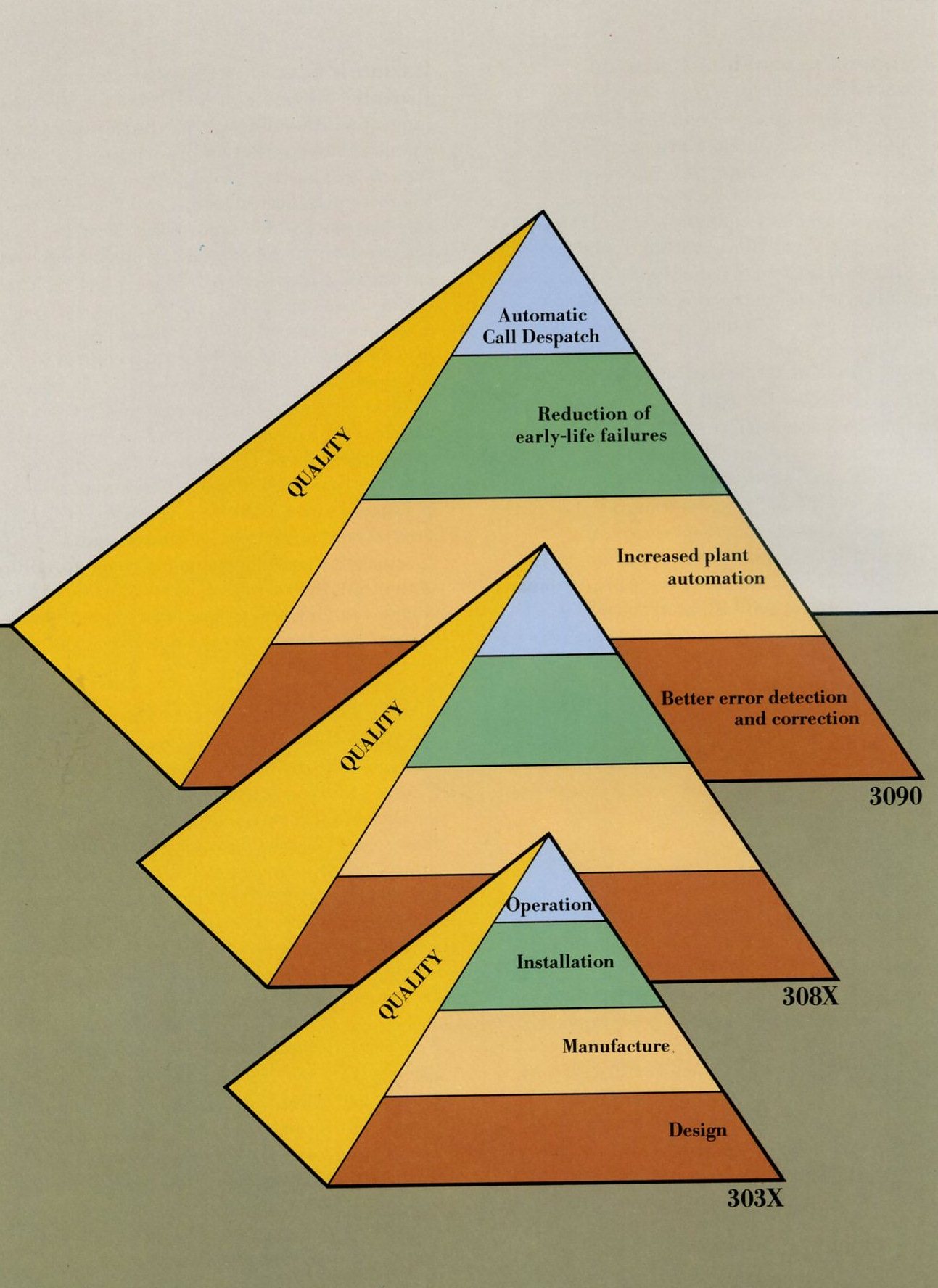
The IBM 3090 was designed from the outset to provide even better availability than IBM's previous family of 308X large system processors. Its high availability is obtained through the use of inherently reliable Thermal Conduction Module technology, through improved manufacturing techniques, through enhanced built-in error detection and correction and through duplication of key components in the maintenance subsystem. To reduce the incidence and impact of failures, the IBM 3092 Processor Controller utilises improved diagnostics and remote support facilities to minimise repair time.
Approximately one quarter of the IBM 3090's circuits are used to provide fault detection and correction. The IBM 3092 Processor Controller has the ability to build up an error history on one or two 730 Mb capacity IBM 3370 disks, including information on intermittent failures. If intermittent errors exceed a threshold, the 3092 automatically contacts the IBM remote support centre by autodial link to request replacement parts.
As processor power increases, larger processor storage is needed to balance the system. Use of a greater quantity of the same technology will result in a proportionate increase in the number of failures. Therefore IBM has introduced a new storage concept for the 3090 which has availability as well as application benefits.
IBM's Expanded Storage, which is used to provide the main growth element in the 3090's processor storage, incorporates an enhanced error correction capability. All double bit errors are detected and corrected. All triple bit errors are detected and some are corrected. In addition, four bit errors in a single block are detected. This makes it possible to install very large quantities of solid-state memory in place of DASD, while improving system availability.
IBM 3090 Central Storage benefits from another innovation designed to avoid the impact of unrecoverable storage failures. This is dynamic frame de-allocation, which, by a combination of hardware, microcode and system control program support, permits storage page frames with correctable double-bit errors to be removed from operation without halting the system. Unless the page remains fixed, the application using the storage that failed is continued without interruption.
The IBM 3092 and the IBM support centres to which it can be connected, are designed to minimise the occurrence of unplanned system outages as well as to reduce repair time. When operating normally in single image mode, failure of the IBM 3090 can be diagnosed in parallel with continued operation of the rest of the system. The appropriate parts information and service request is then supplied automatically to the IBM support centre as well as to Call Dispatch by autodial link {provided that the customer consents).
Usually the 3092 correctly identifies the failing part and enables the IBM customer engineer to fix the fault on his first call. If necessary, the specialists in the remote IBM centre, in the plant of manufacture or in the development laboratory, can exercise the 3090 complex using comprehensive diagnostic routines. At the same time they can give you the benefit of their wide experience derived from handling a large population of IBM 3090 systems.
Customer Feedback from the growing base of IBM 3090 installations confirms the quality of the 3090 in terms of its exceptional availability and ease of installation. The IBM Large System Project Office, which assesses the satisfaction of the 3090 users on a weekly basis, exists to ensure that every 3090 customer is getting the quality product IBM intends. It will continue to maintain the high standards that have already been set.
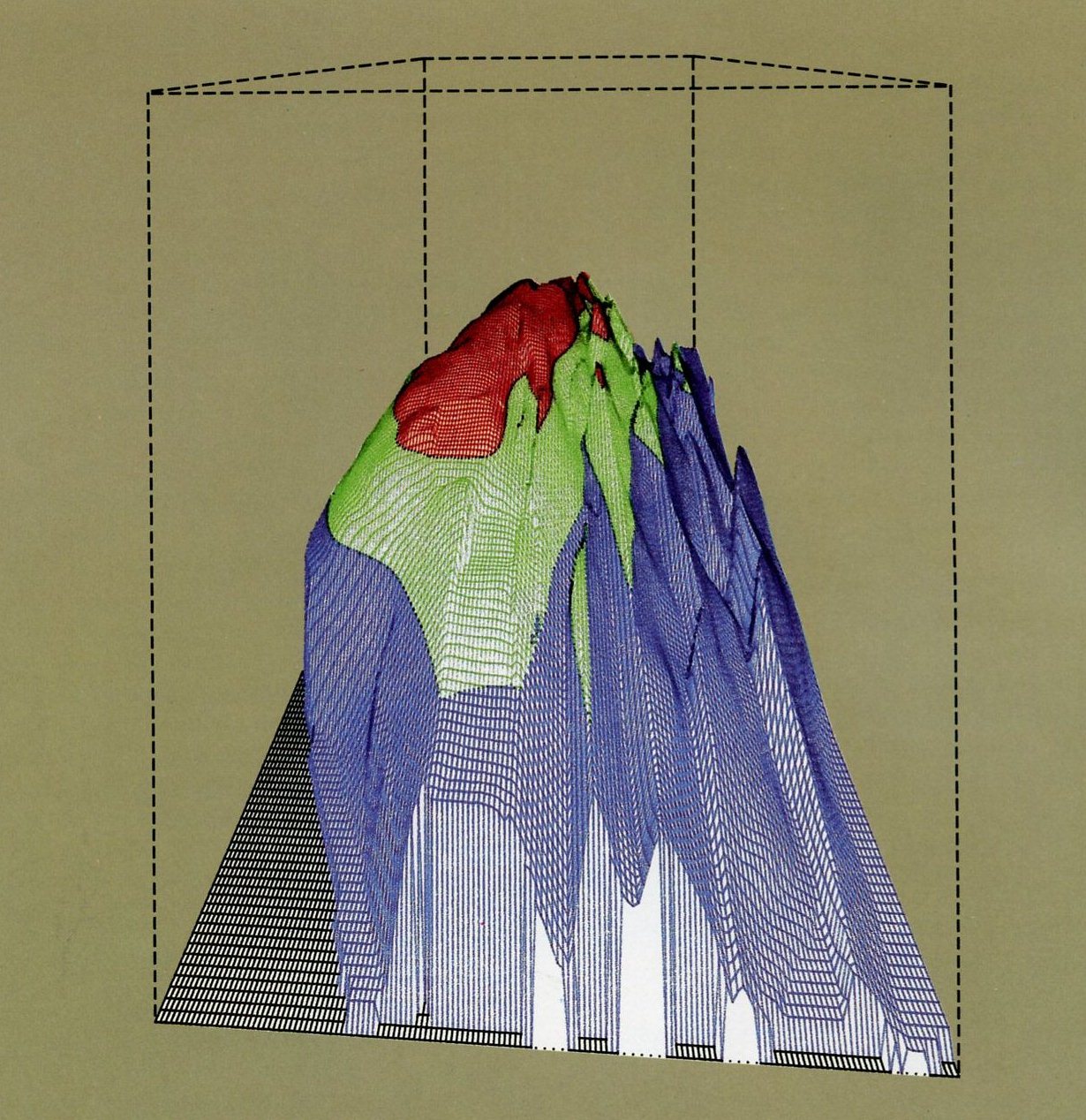
Image produced by ECLIPSE, a software product of Exploration Consultants Limited.
The IBM 3090 was designed from the outset to provide outstanding performance for compute intensive applications. The high speed multiplier, fast add/subtract circuits for floating point calculations and special loop control facilities supplement the overlapped instruction/execution unit design, the 64-bit wide data paths, and the high-capacity 64K-byte high speed buffer in each processor to make the IBM 3090 one of the world's fastest scalar computers.
The MacNeal-Schwendler Corporation provides a booklet entitled "Time Estimation and Problem Execution" with MSC/NASTRAN (NASTRAN is a registered trademark of the National Aeronautic and Space Administration. MSC/NASTRAN is an enhanced proprietary version developed by the MacNeal-Schwendler Corporation.) The August 1986 edition shows that the IBM 3090 Model 200 executes the MSC/NASTRAN multiply-add loop faster than any other non-vector computer listed in the publication.
The optional Vector Facility available for attachment to each processor in an IBM 3090 complex provides a highly cost effective feature which can yield throughput improvements of 1.5 to 3 times for vectorisable programs.
The Vector Facility is made from proven Thermal Conduction Module (TCM) technology like other parts of the 3090. Three TCMs are required for each Facility and three Facilities are accommodated per TCM board.
IBM's VS FORTRAN Program Multitasking Facility permits programs with a high proportion of independent calculations to be split into subtasks and run in parallel on the IBM 3090 Models 200E, 300E, 400E and 600E. Job elapsed time reductions of up to 1.9 times on the Model 200E, up to 2.6 times on the Model 300E, up to 3.3 times on the Model 400E and up to 4.1 times on the Model 600E have been measured for scalar applications. If programs with parallel computation can be also be vectorised, improvements in turnaround time can be a much as 20 times greater.
IBM's VS FORTRAN Version 2 combine Compiler, Library and Interactive Debug in a comprehensive package which can generate highly-optimised object code for scalar or vector execution. Also included is a CPU sampling facility which permits the optimisation of scalar as well as vectorised code by providing "hot spot" analysis. VS FORTRAN Version 2 permits standardisation of all FORTRAN applications on one compiler with improved accuracy and performance.
Supporting VS FORTRAN and the Vector Facility, other IBM software includes an extensive library of engineering and scientific subroutines, an IBM FORTRAN language conversion program and a simulator for the IBM 3838 Array Processor. Also available is the IBM 3090 Vector Facility Simulator. The Simulator permits installation not yet possessing a Vector Facility to run vectorised object programs.
The IBM 3090 Vector Facility can operate under MVS/XA, VM/XA Systems Product, VM/XA Systems Facility or VM/SP High Performance Option. As many Vector Facilities can be added to an IBM 3090 complex as there are central processors. Scalar and vector processing power can therefore be adjusted to meet the changing requirements of the installation, especially during the period in which the main applications are being vectorised. The low relative price of additional Vector Facilities makes it easy to provide back-up or to improve vector job turnaround by installing an additional Facility.
IBM's integrated approach to processing on the 3090 not only makes it possible to combine compute-intensive scalar and vector work on one system, it also allows commercial data centres to handle numerically intensive work which previously required specialised equipment. In both cases, the overheads of running separate installations can be reduced and access to data can be simplified by containing it within a single system.
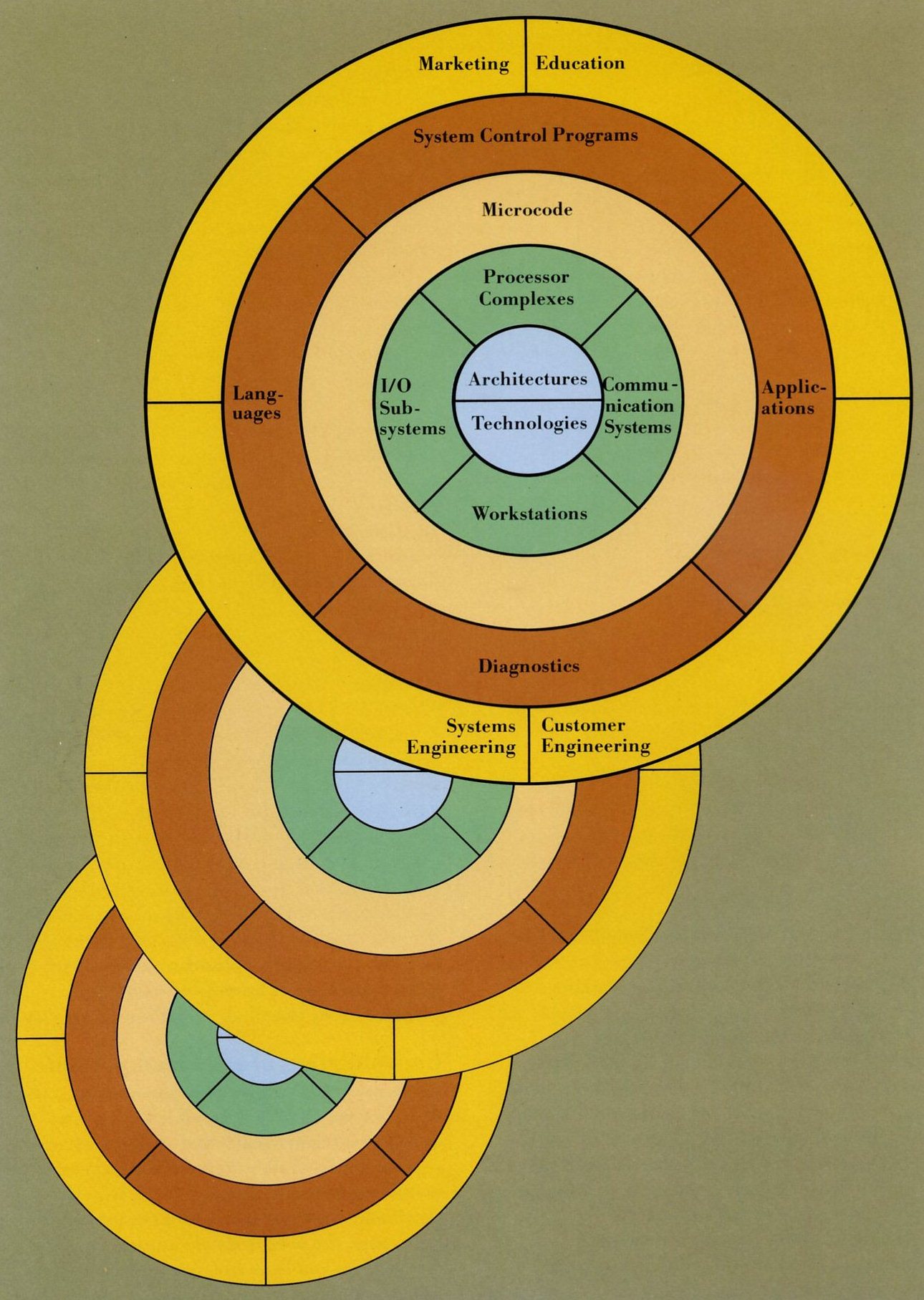
IBM's target is to maintain a complete Information Systems product line composed of synergistic products and offerings which represent the best in the industry, work together to provide balanced systems and match your requirements.
To implement its product plan, IBM establishes architectures and develops technologies to last for a strategic planning period. New architectures are introduced gradually to permit customers and IBM to absorb the change. Systems Network Architecture, announced in 1974, Document Content Architecture and Document Interchange Architecture in 1983, System/370 Extended Architecture in 1981, as well as System Application Architecture in 1987, are among the IBM architectures which currently shape the development of IBM large systems.
Among IBM's technologies, the thin film recording technology of today's IBM DASD and Tape subsystems, the laser printing technology of IBM's system printers and the Thermal Conduction Module packaging of the IBM 3090, all represent technologies which spent several years in the laboratory before their introduction into IBM's products.
Obeying the rules of the architecture and electing the technologies which are proven and ready for volume production, IBM development engineers build the products defined to meet your needs. For example, Dynamic Path Reconnection permits IBM 3380 Disks to transmit data along a path different from that originally used to request the data. This function utilises microcode communication between the channel elements in the Processors Units, the IBM 3880 Storage Controller and the IBM 3380 Disk. IBM coordinates all the enhancement necessary to bring you the benefits in function and performance of all its new products.
Not only is each new IBM product designed to be the best available of its kind in terms of function, it must also exceed the reliability, availability and serviceability standards set by the most similar preceding IBM product. Products are tested internally by independent IBM departments to validate each product's quality before announcement, before general availability and on a continuing basis thereafter. Highly complex products such as the IBM 3090, which require more than just laboratory stress-testing, are installed in a limited quantity of varied customer environments to ensure that they are thoroughly field-tested before general availability.
Once announced, IBM's products are sold delivered and maintained by your account team. They receive the help of IBM's expertise worldwide to provide you with the planning education and maintenance support you require.
IBM is continually studying the future product requirements of its customers, the prime source of information to determine what needs to be developed. As well as receiving and accepting product requirements from user organisations such as SHARE and GUIDE, IBM studies the requirements of individual customers in the USA, Europe, Latin America and the Far East, on a regular basis. Among recent large system announcements, MVS/XA Version 2 Release 2 contains more than 60 enhancements in response to user group requirements, while the IBM 3090 Vector Facility answers a product requirement submitted by SEAS in Europe.
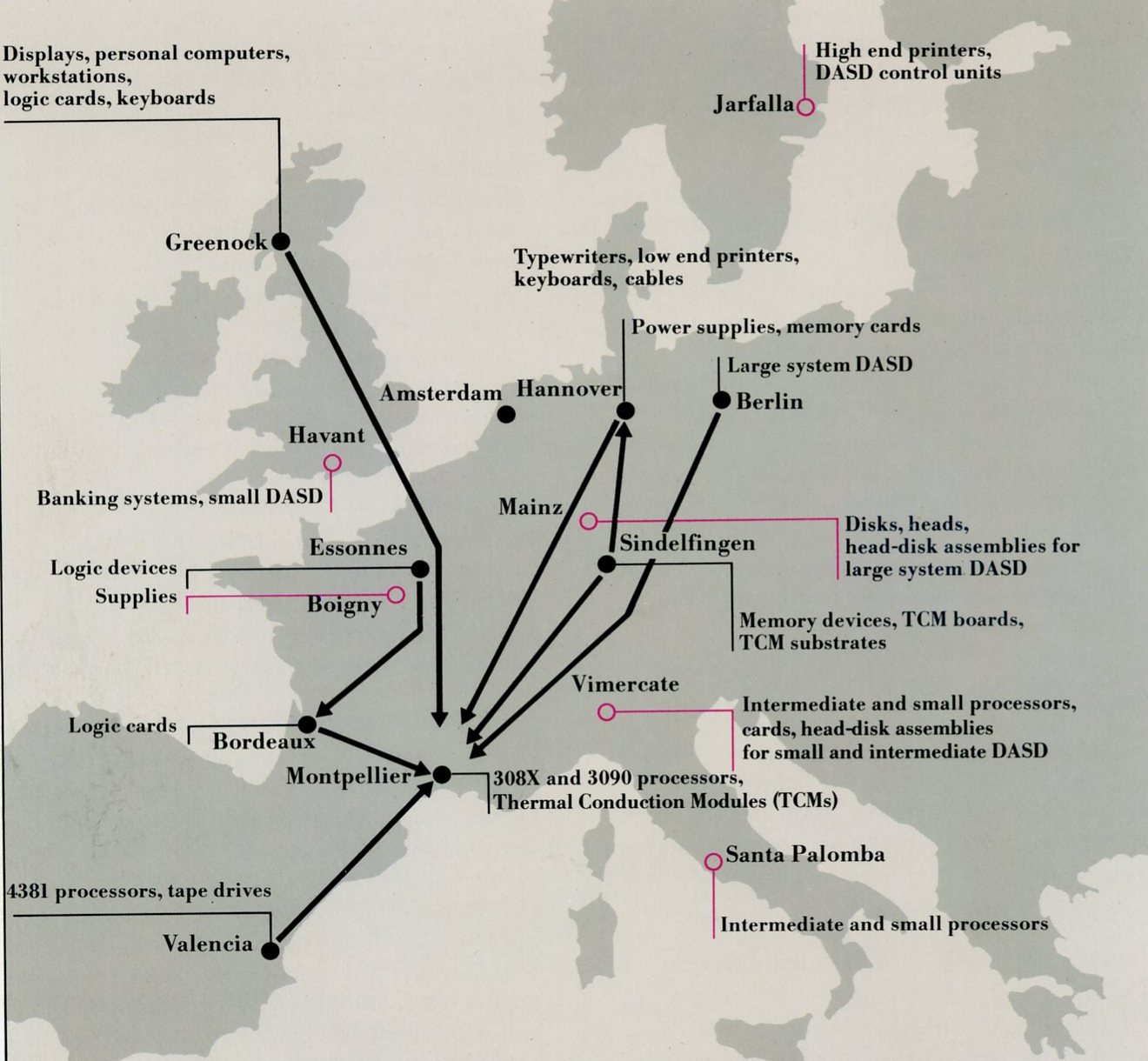
The IBM 3090 reflects IBM's policy of manufacturing products in Europe. Memory chips, Thermal Conduction Module (TCM) substrates and TCM boards are made in Germany. The system consoles are built in the United Kingdom. The logic chips are made in France, where final assembly and testing of the IBM 3090, its TCMs and TCM boards also take place. Other components of IBM large systems are also made in Europe: disks in Germany, tapes in Spain, printers in Sweden, terminals and workstations in the United Kingdom. Helping IBM are thousands of component manufacturers located in virtually every European country, providing, with IBM, jobs and investment for Europe.